Effects of Acupuncture at the Left Weizhong Acupoint on Heart Rate Variability in Thirty Post-Stroke Patients—Results from a Transcontinental Teleacupuncture Study
Bo Pang 1 ![]() , Qi Zhang 2,*
, Qi Zhang 2,*![]() , Guang-Yu Cheng 3
, Guang-Yu Cheng 3![]() , Wei-Ping Cheng 3
, Wei-Ping Cheng 3![]() , Daniela Litscher 4
, Daniela Litscher 4![]() , Lu Wang 1,4
, Lu Wang 1,4![]() , Zemin Sheng 1,5
, Zemin Sheng 1,5![]() , Ingrid Gaischek 4
, Ingrid Gaischek 4![]() , Zhong-Ren Sun 1
, Zhong-Ren Sun 1![]() , Gerhard Litscher 1,4,*
, Gerhard Litscher 1,4,*![]()
- Heilongjiang University of Chinese Medicine, No. 24 Heping Road, Xiangfang District, Harbin 150040, China
- Acupuncture Department, Heilongjiang Academy of Traditional Chinese Medicine, No. 33 Xidazhi Street, Nangang District, Harbin 150006, China
- Acupuncture Department, First affiliated Hospital of Heilongjiang University of Chinese Medicine, No. 26 Heping Road, Xiangfang District, Harbin 150040, China
- Research Unit for Complementary and Integrative Laser Medicine, Research Unit of Biomedical Engineering in Anesthesia and Intensive Care Medicine, and TCM Research Center Graz, Medical University of Graz, Auenbruggerplatz 29, 8036 Graz, Austria
- Private Clinic Laßnitzhöhe, Miglitzpromenade 18, 8301 Laßnitzhöhe, Austria
* Correspondence: Qi Zhang (for China) ![]() ; Gerhard Litscher (for Europe)
; Gerhard Litscher (for Europe) ![]() .
.
Received: June 8, 2016 | Accepted: August 8, 2016 | Published: August 23, 2016
OBM ICM 2016, Volume 1, Issue 1, doi:10.21926/obm.icm.1601003
Academic Editor: Im Quah-Smith
Recommended citation: Pang B, Zhang Q, Cheng GY, Cheng WP, Litscher D, Wang L, et al. Effects of Acupuncture at the Left Weizhong Acupoint on Heart Rate Variability in Thirty Post-Stroke Patients—Results from a Transcontinental Teleacupuncture Study. OBM ICM 2016; 1(1): 003; doi:10.21926/obm.icm.1601003.
© 2016 by the authors. This is an open access article distributed under the conditions of the Creative Commons by Attribution License, which permits unrestricted use, distribution, and reproduction in any medium or format, provided the original work is correctly cited.
Abstract
(1) Background: Within this study, we assessed the effects of acupuncture on heart rate variability (HRV) in Chinese post-stroke patients.
(2) Methods: In 30 Chinese post-stroke patients (14 f, 16 m; mean age ± SD 64.3 ± 3.8 years; range 40 – 80 years) electrocardiographic signals before, during and after acupuncture at the left Weizhong acupoint (BL40) were recorded in Harbin and analyzed in Graz using teleacupuncture via internet. HRV data were analyzed in the time and frequency domain and a protocol from Austria was sent to the team in China immediately after the treatment and recording session.
(3) Results: The standard deviation of normal to normal (SDNN) and total power of HRV (TP) didn’t change significantly during and after acupuncture (P>0.05), whereas high frequency (HF) decreased significantly during and after acupuncture (P<0.01), and low frequency (LF) increased significantly after acupuncture (P<0.05). Therefore, there was a marked increase in balance between sympathetic and parasympathetic activity (LF/HF HRV ratio) during and after treatment.
(4) Conclusions: This study shows that HRV could be a useful parameter for quantifying regulatory effects of acupuncture on the autonomic nervous system. Together, our findings showed that acupuncture of the Weizhong point on the left side of the patients after cerebral infarction has no obvious influence on the heart rate and total HRV, but has an inhibitory effect on the vagus and excitatory effect on the sympathetic nerve.
Keywords
Traditional Chinese Medicine (TCM); Teleacupuncture; Heart Rate Variability (HRV);
Sino-Austrian Cooperation; Post-stroke
Introduction
The technology of teleacupuncture has been implemented at the TCM Research Center Graz in Austria in cooperation with Heilongjiang University of Chinese Medicine in Harbin and the China Academy of Chinese Medical Sciences in Beijing, China [1,2,3]. In China, electrocardiograms (ECGs) are recorded and the data are transferred via internet to the Medical University of Graz immediately following the acupuncture treatment. In Graz, the analysis of the ECGs is performed. The acupuncturists in China are informed about the results of the analysis immediately and the success of the therapy can be demonstrated objectively. Teleacupuncture, on the one hand, bridges Eastern and Western medicine and, on the other hand, science and practice; it may also contribute to the omission of redundant research studies and a simplification of the diagnostic and therapeutic procedure, thereby not only cutting costs but also saving time [4]. The latest HRV-related acupuncture research findings can be found in a new book released in July 2016 [4].
This paper describes the results from teleacupuncture measurements in post-stroke patients using computer-based heart rate variability (HRV) recordings before, during and after acupuncture under standardized clinical conditions in Harbin, China. Data analyses were performed in Graz, Austria.
Ethics Statement
The study was approved by the Ethics Committee of Heilongjiang University of Chinese Medicine (No 2010HZYLL-030) and carried out in compliance with the Declaration of Helsinki. All patients provided oral informed consent after they were informed about the nature of the investigations as far as the study design allowed.
Materials and Methods
Patients in Harbin
We investigated 30 adult post-stroke (Chinese diagnosis ‘Zhong Feng’) patients (14 female, 16 male; mean age ± SD: 64.3 ± 3.8 years; range: 40 ─ 80 years) who received acupuncture treatment. This diagnosis means that all patients had wind stroke (Zhong Feng) attacking the channels and collaterals caused by increased liver yang and kidney yin deficiency. The patients were not under the influence of centrally acting medications, and none of them had a body temperature out of the normal range.
Biosignal Recording in China and Data Analysis in Austria
The HRV is measured during a special time period (5 min), and thus determined. Electrocardiographic (ECG) recording was performed using three adhesive electrodes which were applied to the chest. The Chinese researchers used a medilog® AR12 HRV (Huntleigh Healthcare, Cardiff, United Kingdom) system from the TCM Research Center in Graz for the common investigations.
The raw data were stored digitally on a memory card. After removing the card from the portable system, the data were read by a card reader connected with a standard computer in China and then transferred to the TCM Research Center Graz via internet. The signals were analyzed and HRV was displayed in a way to help to evaluate the function of the autonomic nervous system which helps to show how well the human body reacts to sport, stress, recovery and also acupuncture [4,5]. The standard deviation of normal to normal (SDNN), total power (TP), high frequency (HF), low frequency (LF) and the LF/HF ratio of HRV were chosen as the evaluation parameters [6,7].
Acupuncture and Procedure
All patients received manual needle acupuncture at the acupoint Weizhong (BL40) on the left bladder meridian. Weizhong is located in the middle of the popliteal fossa, between the tendons of biceps femoris and semitendinosus (Figure 1). Its use is indicated for example in cases of lumbago and sciatica. Sterile single-use needles (0.30 × 30 mm; Huan Qiu, Suzhou, China) were used. Needling was performed perpendicularly (depth about 15 mm), and the needle was stimulated clockwise and counterclockwise for 15 seconds each stimulation, with six rotations per second, resulting in 90 rotations per stimulation. Stimulation was done immediately after inserting the needle, 10 minutes later and before removing the needle (Figure 2).
Statistical Analysis
Data were analyzed using SPSS 18.0 software (SPSS Inc., Chicago, IL). Graphical presentation of results uses box plot illustrations. Statistical tests were performed with Friedman repeated measures ANOVA on ranks and Tukey test. The criterion for significance was P<0.05.
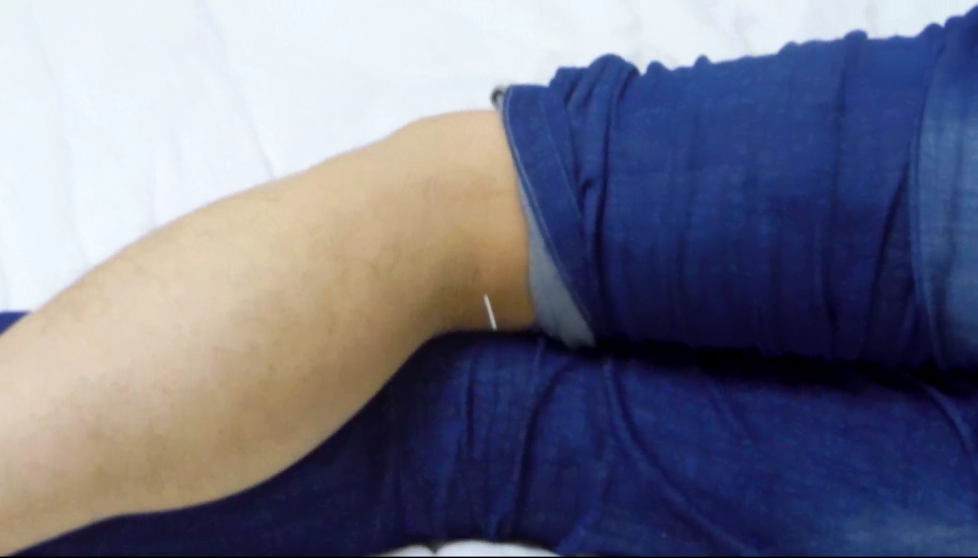
Figure 1 Manual needle acupuncture at the acupoint Weizhong (BL40, left).
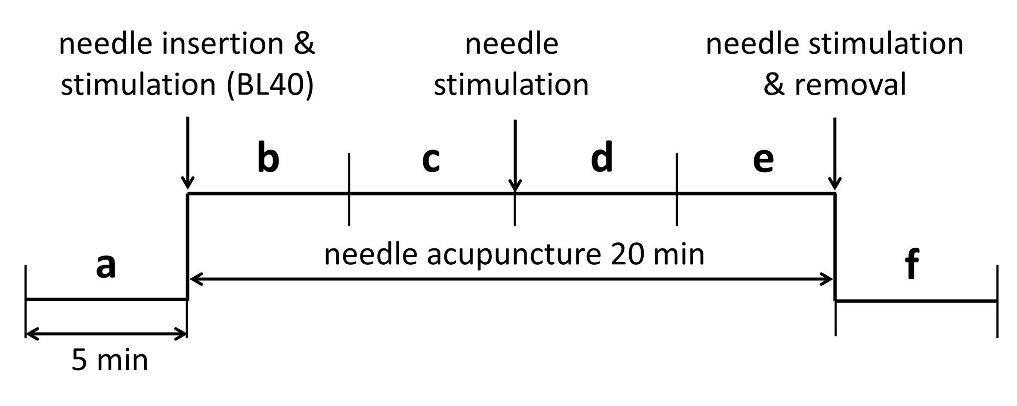
Figure 2 Measurement procedure. The data before (measurement phases a), during (b-e) and after (f) manual needle acupuncture stimulation at the acupoint Weizhong were measured and statistically analyzed.
Results
Figure 3 shows the results of SDNN from the ECG recordings before, during and after the acupuncture treatment of the 30 patients. There was no significant change in SDNN during and after the acupuncture treatment (P>0.05).
Figure 4 shows the results of total power (TP) from the ECG recordings before, during and after the acupuncture treatment of the 30 patients. There was also no significant change in TP during and after acupuncture (P>0.05).
In contrast to the results of TP, the power in the HF-band decreased significantly (P<0.01) during (b-e) and after (f) the needle acupuncture treatment (Figure 5).
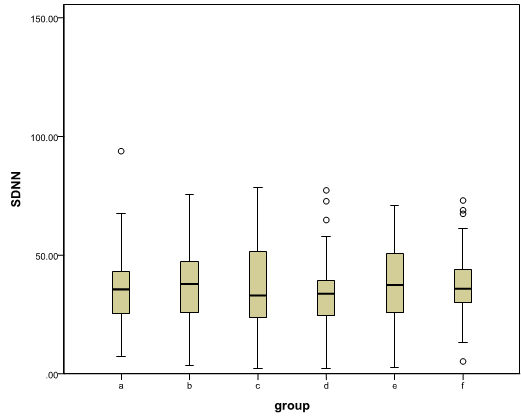
Figure 3 Box plot illustration of SDNN [ms] in 30 post-stroke patients before (a), during (b-e) and after (f) needle acupuncture. There were no significant changes (P>0.05). The ends of the boxes represent the 25th and 75th percentile, the line in the box indicates the median. The error bars mark the 10th and 90th percentile, and the dots represent the outliers.
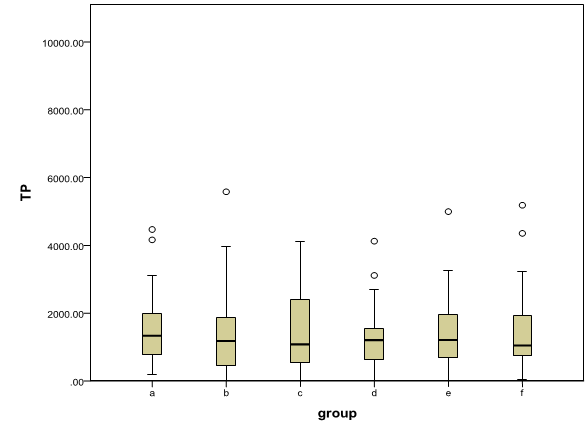
Figure 4 Box plot illustration of TP [ms²/Hz] in 30 post-stroke patients before (a), during (b-e) and after (f) needle acupuncture treatment. There were no significant changes (P>0.05).
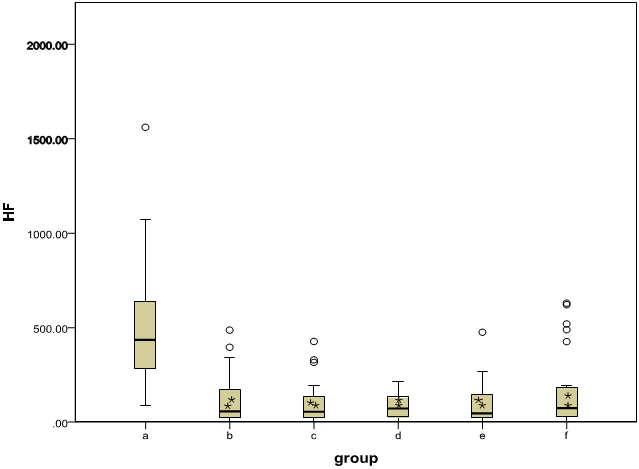
Figure 5 HF [ms²/Hz] band of HRV. ** P<0.01.
A graphical presentation of the calculation of the LF-band can be found in Figure 6. The decrease of LF was significant in phases c, e, and f. LF/HF ratio increased during (b-e) and after (f) needle acupuncture (Figure 7).

Figure 6 LF [ms²/Hz] band of HRV. ** P<0.01.
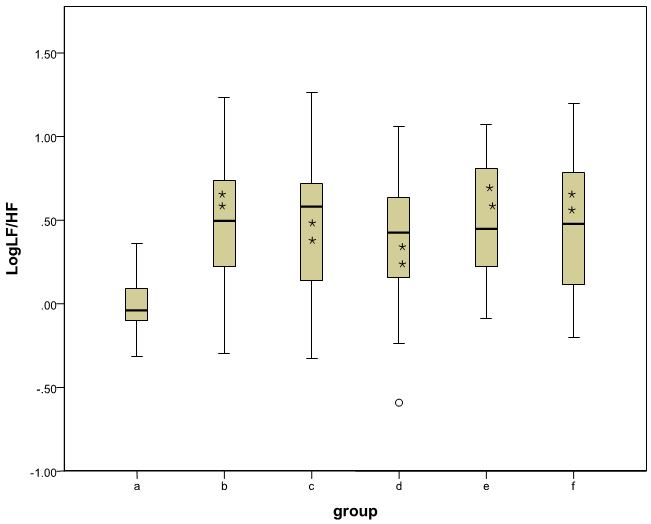
Figure 7 Log LF/HF band of HRV. ** P<0.01.
Discussion and Conclusion
A novel concept of the so-called teleacupuncture technology was implemented in 2010 at the TCM Research Center Graz in Austria (http://litscher.info) in cooperation with Heilongjiang University of Chinese Medicine in Harbin, China over a distance of about 8,500 km [1]. The concept has been used in several studies since then, for example to investigate basic effects of acupuncture stimulation in post-stroke patients [1], in patients with insomnia [8] or depression [9], but also in patients with cervical spine syndrome [5] and tachycardia [5].
HRV can be used as a reliable indicator of the state of health. It becomes less random with the aging process and the appearance of age-related diseases. However, it could be demonstrated that in special syndromes like fatigue and stress one can counteract this process using different preventive methods like acupuncture. This has been demonstrated in recent investigations concerning patients with burn-out syndrome as performed in transcontinental teleacupuncture studies between China and Graz [4].
Within the present study, the mechanism by which acupuncture affects total HRV was not uncovered; however, acupuncture did change HRV to some extent. Additionally, we also found that the time domain index SDNN and frequency domain index TP did not change compared to those before therapy, indicating that the total HRV of the post-stroke patients was not affected by acupuncture. Intriguingly, the other frequency domain indexes, HF and LF, decreased, but the LF/HF ratio increased, so we assumed that the degree of HF drops was greater than that of LF.
It is not easy to interpret the findings as discussed above, as HRV can also be affected by diverse conditions and different medications [1,2,3,4,6]. The decrease of HF might indicate that the vagus system was restrained and the sympathetic nervous system was excited relevantly, but the whole autonomic nervous system in general was not changed. The increase in sympathetic function induced by acupuncture may, however, not be desirable in stroke patients, therefore, doctors need to be careful when using this acupoint alone for the treatment of stroke patients. In retrospect, according to TCM, if LR8 and/or KI10 had been selected to manage the TCM liver and kidney changes in the stroke patients, the LF/HF ratio may have decreased and hence sympathetic overload would have been downregulated as desired. Recent evidence reveals LR8 as a possible motor rehabilitation point in needle acupuncture [10].
The main findings of this study in 30 post-stroke patients were that acupuncture has no effect on total HRV while at the same time HF and LF changed. This Sino-Austrian collaboration also demonstrated that the exchange of medical acupuncture information across distance (teleacupuncture) is an innovative concept and could probably be useful in future transcontinental acupuncture research and education methodology concepts.
Acknowledgments
LW, ZMS and GL are also Visiting Professors at Heilongjiang University of Chinese Medicine in Harbin.
Author Contributions
PB, ZQ, GYC, WPC and ZRS performed the acupuncture and HRV measurements in post-stroke patients in Harbin and drafted the manuscript. DL, LW, ZMS, IG and GL performed the data analysis of all 30 patients in Graz and revised and completed the manuscript.
Funding
The study was supported by the Austrian Federal Ministry of Science, Research and Economy within the Sino-Austrian TCM cooperation.
Competing Interests
The authors have declared that no competing interests exist.
References
- Wang L, Valentini J, Sugimoto K, Cheng WP, Cheng GY, Geng HM, et al. Biomedical Teleacupuncture between China and Austria Using Heart Rate Variability, Part 1: Poststroke Patients. Evid Based Complement Alternat Med. 2011;2011:782489. [CrossRef] [PubMed]
- Litscher G. Translational research in acupuncture – Teleacupuncture bridges science and practice. Health 2010;2:16-19. [CrossRef] [CrossRef]
- Litscher G. Integrative laser medicine and high-tech acupuncture at the Medical University of Graz, Austria, Europe. Evid Based Complement Alternat Med 2012;2012:103109. [CrossRef] [PubMed]
- Litscher G, ed. Heart rate variability and acupuncture – Results from transcontinental studies. Lengerich Berlin Bremen: Pabst Science Publishers; 2016.
- Lopes P, White J. Heart rate variability: Measurement methods and practical implications. In: Maud PJ, Foster C, eds. Physiological assessment of human fitness. 2nd ed. Champaign, IL: Human Kinetics; 2006. pp. 39-62.
- Litscher G, Wang LP, Wang L, Liu CZ, Wang XM. Sino-European Transcontinental Basic and Clinical High-Tech Acupuncture Studies – Part 4: “Fire of Life” Analysis of Heart Rate Variability during Acupuncture in Clinical Studies. Evid Based Complement Alternat Med. 2012;2012:153480. [CrossRef] [PubMed]
- Task force of the European Society of Cardiology and the North American Society of Pacing and Electrophysiology. Heart rate variability: Standards of measurement, physiological interpretation and clinical use. Eur Heart J. 1996;17:354-381. [PubMed] [CrossRef]
- Wang L, Cheng WP, Sun ZR, Xu YY, Cheng GY, Gaischek I, et al. Ear acupressure, heart rate, and heart rate variability in patients with insomnia. Evid Based Complement Alternat Med. 2013;2013:763631. [CrossRef] [PubMed]
- Shi X, Litscher G, Wang H, Wang L, Zhao ZK, Litscher D, et al. Continuous auricular electroacupuncture can significantly improve heart rate variability and clinical scores in patients with depression: First results from a transcontinental study. Evid Based Complement Alternat Med. 2013;2013:894096. [CrossRef] [PubMed]
- Quah-Smith I, Williams MA, Lundeberg T, Suo C, Sachdev P. Differential brain effects of laser and needle acupuncture at LR8 using functional MRI. Acupunct Med. 2013;31:282-289. [CrossRef] [PubMed] [CrossRef]


